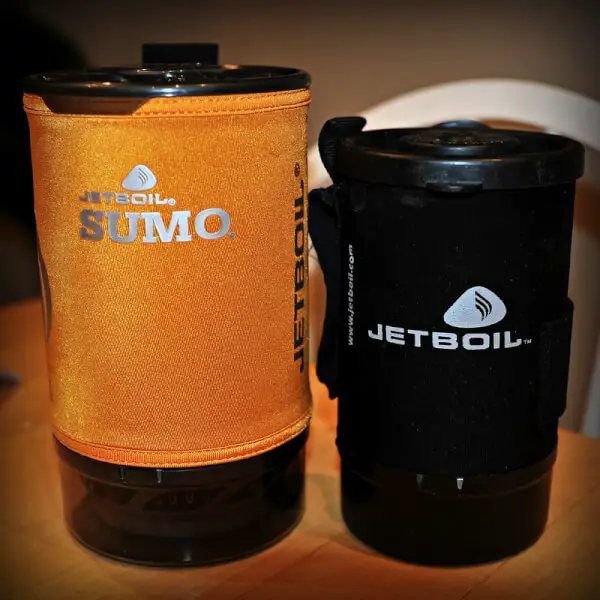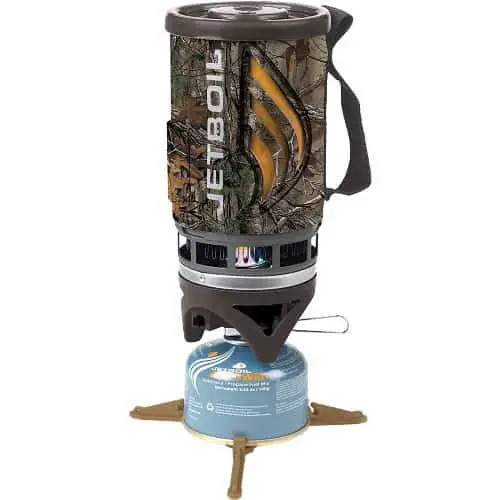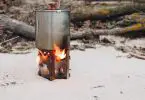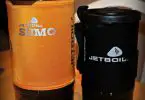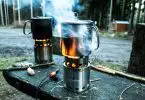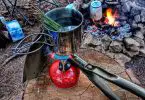Outdoor traveling like hiking and camping are activities which has a completely different standard from your normal everyday life. From the clothing to food and shelter to washroom, everything is to be adhered according to the conditions. There are a lot of things which you must know and be well prepared prior to starting your journey for the wilderness.
One of those important things is the camping/hiking stove or cooking system which are included in the basic essentials of outdoor travel. This article will help you in finding the answer for your query of choosing the appropriate and suitable cooking system between the Jetboil Flash VS Zip.
There are numerous cooking system or stoves available in the market and it is no doubt a most difficult decision to choose the right and best one amongst many. However, as per our research and with the consultation of experts, the integrated canister cooking system is the most common system used in outdoor travel.
Therefore, we will be discussing this very class of cooking system in order to give you a brief overview and help you choose in the end. The usage of this class of cooking system has significantly increased in the past few years due to their unique standard and advantages.
Why a Canister Cooking System?
By reading the intro of this article you will definitely be having a question in your mind that why we focused on the canister stoves only? There are multiple answers and reasons for this question.
One of the core reasons is the light weight and portability of these stoves. Burning on light gases like propane and butane, these stoves are easy to operate without the frustration that’s associated with wood fire and other stoves.
The canister stoves like Jetboil Flash and Zip Flash have been therefore the ultimate choice of the hikers, mountaineers, campers and adventurers. Because it helps them save a lot of time lighting the stove and it hardly takes few minutes when boiling water or preparing a quick meal in them. Other reasons include the easy adjustability, convenience and speedy performance.
One of the major problems faced after the invention of canister cooking system in 2004 was the inefficient operation during windy conditions and also it wasn’t possible to be used with a windscreen. Realizing this very problem, the manufacturers focused on designing and developing an integrated cooking system with latest additions and modifications to make it more efficient even in the unfavorable environmental conditions.
For example, the inclusion of heat exchanger surrounding the burner helped protect the stove from the wind. The usage of blended gases like propane, butane or iso-butane helped in keeping these canister stoves stable and operational even in the cold temperatures below freezing points.
Parameters for Comparison
Before giving you a detailed review of the two integrated canister stoves mentioned above, it is necessary to know about the deciding parameters and criteria of their comparison. Although there could be many but we will be focusing on the important and effective ones recommended by experts. Those parameters are the following:
- Size
- Weight
- Stability
- Versatility
- Performance
- Fuel Efficiency
- Boiling Time
- Pricing
- Users’ Ratings
Now, detailed notes on these parameters will be discussed along with the pros and cons in each category thus giving you an easy option of deciding and choosing the most suitable outdoor cooking system.
Size
The integrated canister stoves are available in a very little variation in sizes. However, almost all of them are sized enough to accommodate in your backpack easily without holding huge space.
The Jetboil Flash packed size has a dimension of 7.1 * 4.1 inches normally. Although having the capacity of about 1 liter yet the cup size is smaller as compared to its counterparts.
On the other hand, Flash Zip packed size has a dimension of 6.5 * 4.1 inches with 0.8-liter cup capacity. The difference is only 0.6 inch in both these products but the cup capacity has a huge variation which drops down by 20% in the case of Zip.
Most of the survival experts prefer the cup capacity and not the entire size of the stove. In the light of this opinion, Jetboil Flash is recommended which has a good cup capacity where you can easily boil a liter of water or prepare coffee for 3 to 4 people.
It is because the Jetboil Flash has also the capacity of replacing the 1-liter cup with another one having the capacity of 1.5 liters which can be bought separately. On the contrary, if you are a solo traveler or only a group of two, Zip is going to fulfill your needs easily as 0.8 liter is enough for serving 2 people.
Weight
As mentioned earlier, the latest cooking systems have dominated the market due to its smaller size and light weight as compared to the traditional outdoor cooking systems. Thus, it becomes tough for buyers to rely on this only parameter and decide. Just like the size, the flash has a very minimal variation in its weight.
The Jetboil Flash is weighed only at 13.2 ounces and when broken down into components the pot, burner and cup are 7.9, 5.1 and 1.2 ounces respectively. Since you have the option of replacing the cup to increase the capacity, it will definitely be adding to its weight by a few ounces. The Zip Flash on the other side weighs only 12 ounces and is much lighter than the former one.
If your target is lighter weight, our recommendation will be the Zip. However, you must know that the auto-ignition system is not available in the Zip just like Jetboil Flash and you will be needing a matchbox or ignition lighter for the purpose. The choice only redirects to Jetboil when it comes to the cup capacity but comparing the weights of a larger cup with a matchbox or ignition lighter purely supports the zip when it comes to the criteria of weight.
Stability
Stability of the outdoor cooking stoves is no doubt one of the major problems which are very prominent in canister stoves like Jetboil Flash and Zip. The reason for their instability is, of course, the light weight and uniform sizes of the canister and the base on which it is placed.
As a result, the stove becomes much taller and is easily blown by the wind. The stoves with wider bases and shorter length are more stable and consistent but this feature is lacking in these two products.
To overcome the problem of stability, the manufacturers later introduced the canister stands (lower tripod stands) which are attached to the base making it stable and firm to avoid unnecessary movement and blowing.
But it is very obvious that bringing along the additional tripod stand is contradicting the fact and feature of these cooking systems being lighter and portable. Thus, comparing the above two canister stoves, the Jetboil Flash being heavier than the Zip have higher stability.
Versatility
Unlike the classical cooking systems, the integrated canister stoves are available with extraordinary features and modified designs. Not only the shape and design but performance wise also, these stoves have a lead on others. The selection of one in terms of versatility is all dependent upon your need and requirements.
If only boiling water, preparing coffee and cooking soup is your requirement then Jetboil Flash is there for fulfilling your need in taking only a few minutes of time. However, if your intentions and requirements are more than just boiling water and preparation of coffee then these light weighted canister stoves are going to fail you. You must switch to other multi-fuel cooking systems capable of preparing food for larger groups.
The Jetboil Flash comes with an external temperature indicator and Jetboil FluxRing Technology helps in reducing the extra heat loss. The color of the temperature indicator changes with the change in temperature of the food during the cooking process. Along with this, the piezo ignition system is one of the best features of this stove making it more unique and versatile in performance.
The Zip, lacking all such advanced features is, therefore, lagging behind and less versatile in performance than Jetboil Flash.
Performance
The canister stoves are believed to be on the top in performance relative to other cooking systems. It is because of the reliability and ease in its performance. The Jetboil Flash, as mentioned earlier has the auto-ignition feature which results in the saving of time and extra efforts for cooking.
The Jetboil Flash and Zip, both are featured with heat exchangers at the bottom of the pot around the burner helping in:
- Maximizing the heat transfer
- Reducing the extra heat loss
- Protection of the flame from wind
In between the two, convenience, reliability and compactness is common which adds to enhance the performance of these cooking systems. The Zip Flash is, however, prioritized performance wise as per the recommendations of the expert hikers and adventurers because of being more fast and efficient in operation.
Fuel Efficiency
No one would ever like to run out of fuel in any case whether it is a long drive journey in the deserts or fishing in the wild in a mini generator operating boat. Since the outdoor activities have almost zero tolerance for such situations, therefore, the fuel source and operating devices must be taken care of on priority basis.
If you have multiple stoves available but all out of fuel in the wild will definitely be of no value at all. Therefore, who would not want to have one which is very fuel efficient and outstanding in performance?
According to the manufacturer’s claim, the Jetboil Flash is capable of boiling 100 cups of water with only 100 g canister tank with iso-butane/propane fuel. It is almost 12 liters of water which is well enough for an outdoor activity of a week for two people.
The Zip is also claimed to have the same fuel efficiency and capability of boiling 12 liters of water in 100 g canister Jetpower fuel. Since both of them are providing the same results in fuel efficiency, therefore, the decision in this regard should be relative to other parameters according to the user’s requirements.
Boiling Time
The numerous tests and experiments done on different cooking systems revealed that the boiling time of Flash cooking system is more reliable and fast than others like liquid fuel stoves etc. The average time for integrated canister stoves is 2.5 minutes in normal weather.
The boiling time of Jetboil Flash rises up to 3.5 – 4 minutes in cold and windy weather. On the other side, Zip has an average boiling time of 2.4 minutes in normal and calm weather conditions.
It is worth to be noted that the small canister stoves have less boiling time as compared to these integrated canister stoves. But the only thing which makes it more appealing choice is the wind resistance ability of them.
Both the Jetboil Flash and Zip have good resistance to the wind which other types of cooking systems do not have. Although the boiling time of Flash is more yet it is preferred over Zip because of the color-changing temperature indicator which is helpful to prevent overboiling.
Pricing
Well, looking into the technical aspects of both the stoves, pricing might not be in the very core aspects of the selection criteria. However, most of the adventurers and hikers do consider it as a useful parameter. The many differences in both the Jetboil Flash and Zip are already mentioned and there would not be two opinions on the fact that the differences are slight between them.
But the difference in prices of both the stoves is quite astonishing. The Zip being cheaper by about 20% from the Jetboil Flash once again becomes the good choice. The Zip is priced $80 while the Jetboil Flash is available for about $100.
Users’ Ratings
When you are in a complex situation and confusion and unable to take a decision about choosing a product among many, the user’s reviews and ratings are really helpful in such situations.
The results of our thorough research in leading online shopping sites like amazon showed that the users of the Jetboil Flash are more than Zip. The former is rated 4.8/5.0 while the later one with 4.7/5.0. So from the users’ perspective and customer experience, Jetboil Flash is categorized as the best choice.
Conclusion
Concluding the discussion we tried to provide you with detailed reviews and recommendations mostly based on the opinions and experiences of expert hikers, campers, survivors and adventurers.
| Parameter | Jetboil Flash | Zip Flash |
| Size and Weight | Larger & Heavy | Smaller & Lighter |
| Fuel Efficiency | Excellent | Excellent |
| Features | Advanced & Numerous | Limited |
| Pricing | Expensive | Cheaper |
| Rating | 4.8/5.0 | 4.7/5.0 |
Jetboil Flash
- 1.0 Liter FluxRing® cooking cup with insulating cozy
- The Flash runs on 100-gram Jetpower fuel canisters, which provide enough energy to boil 12 liters or 100 cups of water each
- A simple-to-use electric igniter makes lighting the burner and operating the Flash quick and easy
- A neoprene lining encases the FluxRing cooking cup, keeping food and beverages warm long after heating
- Insulating drink-through lid and bottom cover
Jetboil Zip
- A simple and easy-to-use 0.8 Liter cooking system, featuring the same FluxRing® technology as other higher end systems, without the frills
- Adjustable burner, match ignition
- Drink-through lid with pour spout & strainer
- Bottom cover doubles as a measuring cup and bowl
- Compatible with all Jetboil accessories
- Able to store a 100g Jetpower fuel can
- Included Fuel Canister Stabilizer
- Pot Support and Jetpower fuel sold separately
- Zip is so compact and light-weight, you’ll keep it on hand for day trips close to home and overnight adventures alike
You might be definitely now in a position to take the decision for yourself after knowing the selection criteria and deciding parameters in great detail. Still, if you have any ambiguity or questions, leave a comment and we will try to help you in all the possible ways we can.
If you have already made a choice now we would love to explore your personal experience with any of these outdoor cooking stoves. Do not forget to share your experience and valuable suggestions/recommendations for our readers and beginner level hikers in the comment section.
Featured Image Source: https://www.flickr.com/photos/light_seeker/7505351426


